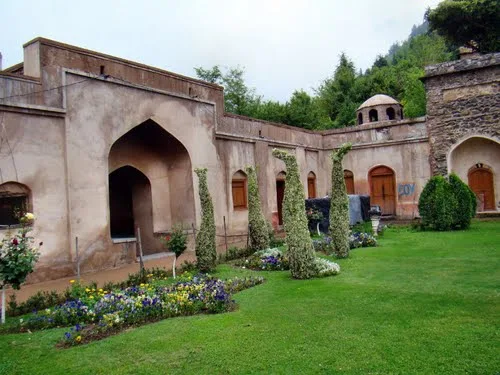Dal Lake is in Srinagar (Dal Lake is a misnomer as Dal in Kashmiri means lake), the summer capital of Jammu and Kashmir. The urban lake, which is the second largest in the state, is integral to tourism and recreation in Kashmir and is named the "Jewel in the crown of Kashmir" or "Srinagar's Jewel". The lake is also an important source for commercial operations in fishing and water plant harvesting.
The shore line of the lake, is about 15.5 kilometres (9.6 mi), is encompassed by a boulevard lined with Mughal era gardens, parks, houseboats and hotels. Scenic views of the lake can be witnessed from the shore line Mughal gardens, such as Shalimar Bagh and Nishat Bagh built during the reign of Mughal Emperor Jahangir and from houseboats cruising along the lake in the colourful shikaras. During the winter season, the temperature sometimes reaches −11 °C (12 °F), freezing the lake.
The lake covers an area of 18 square kilometres (6.9 sq mi) and is part of a natural wetland which covers 21.1 square kilometres (8.1 sq mi), including its floating gardens. The floating gardens, known as "Rad" in Kashmiri, blossom with lotus flowers during July and August. The wetland is divided by causeways into four basins; Gagribal, Lokut Dal, Bod Dal and Nagin (although Nagin is also considered as an independent lake). Lokut-dal and Bod-dal each have an island in the centre, known as Rup Lank (or Char Chinari) and Sona Lank respectively.
At present, the Dal and its Mughal gardens, Shalimar Bagh and the Nishat Bagh on its periphery are undergoing intensive restoration measures to fully address the serious eutrophication problems experienced by the lake. Massive investments of approximately US$275 million (11 billion) are being made by the Government of India to restore the lake to its original splendour.
The shore line of the lake, is about 15.5 kilometres (9.6 mi), is encompassed by a boulevard lined with Mughal era gardens, parks, houseboats and hotels. Scenic views of the lake can be witnessed from the shore line Mughal gardens, such as Shalimar Bagh and Nishat Bagh built during the reign of Mughal Emperor Jahangir and from houseboats cruising along the lake in the colourful shikaras. During the winter season, the temperature sometimes reaches −11 °C (12 °F), freezing the lake.
The lake covers an area of 18 square kilometres (6.9 sq mi) and is part of a natural wetland which covers 21.1 square kilometres (8.1 sq mi), including its floating gardens. The floating gardens, known as "Rad" in Kashmiri, blossom with lotus flowers during July and August. The wetland is divided by causeways into four basins; Gagribal, Lokut Dal, Bod Dal and Nagin (although Nagin is also considered as an independent lake). Lokut-dal and Bod-dal each have an island in the centre, known as Rup Lank (or Char Chinari) and Sona Lank respectively.
At present, the Dal and its Mughal gardens, Shalimar Bagh and the Nishat Bagh on its periphery are undergoing intensive restoration measures to fully address the serious eutrophication problems experienced by the lake. Massive investments of approximately US$275 million (11 billion) are being made by the Government of India to restore the lake to its original splendour.
The lake is popular as a visitor attraction and a summer resort. Fisheries and the harvesting of food and fodder plants are also important on Dal. Weeds from the lake are extracted and converted into compost for the gardens. It also serves as a flood lung of the Jhelum River. Swimming, boating, snow skiing (particularly when the lake is frozen during the severe winter), and canoeing are amongst some of the water sports activities practised on the lake.
The lake has numerous sites and places of interest, many of which are important to the cultural heritage of Srinagar. Aside from the Shalimar Bagh and Nishat Bagh, some of the other places frequented by tourists are the Shankaracharya temple, the Hari Parbat, the Nagin Lake, the Chashme Shahi, the Hazratbal Shrine, and the Mazar-e-Shura cemetery containing the graves of famous Mughal-era poets. Visitors and native alike also enjoy relaxing on the water in a houseboat or a shikara boat, often called "the Gondola of Kashmir
Dal lies in heart of the Srinagar city and is well connected by road and air links. The nearest airport, which connects with other major cities in the country, is about 7 kilometres (4.3 mi) away at Badgam. The nearest railway station is 300 kilometres (190 mi) away at Jammu. The National Highway NH1A connects the Kashmir valley with rest of the country. Shikaras provide a water taxi service available to see the sights in the Dal and to approach the houseboats moored on the lake periphery
The lake has numerous sites and places of interest, many of which are important to the cultural heritage of Srinagar. Aside from the Shalimar Bagh and Nishat Bagh, some of the other places frequented by tourists are the Shankaracharya temple, the Hari Parbat, the Nagin Lake, the Chashme Shahi, the Hazratbal Shrine, and the Mazar-e-Shura cemetery containing the graves of famous Mughal-era poets. Visitors and native alike also enjoy relaxing on the water in a houseboat or a shikara boat, often called "the Gondola of Kashmir
Dal lies in heart of the Srinagar city and is well connected by road and air links. The nearest airport, which connects with other major cities in the country, is about 7 kilometres (4.3 mi) away at Badgam. The nearest railway station is 300 kilometres (190 mi) away at Jammu. The National Highway NH1A connects the Kashmir valley with rest of the country. Shikaras provide a water taxi service available to see the sights in the Dal and to approach the houseboats moored on the lake periphery























































